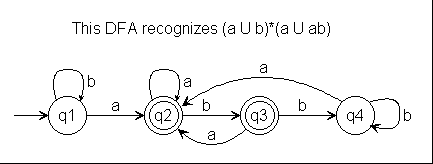
CSci 301 Lecture Notes
Week Three, Tuesday: Context-Free Grammars
A context-free grammar is a collection of substitution rules (productions)
defining how variables yield (produce) strings of variables and
terminals. These substitution rules (that replace variables) are
applied in sequences called derivations to produce all the strings
in the language of the grammar (context-free language). The information
in a single derivation may be represented pictorially in a parse tree.
Examples: grammars G1 and G2.
Formal Definition of a Context-Free Grammar
Definition 2.1.
Examples of Context-Free Grammars
Examples 2.2 and 2.3.
Designing Context-Free Grammars
Four rules-of-thumb when approaching problems requiring creativity:
- Union rule: divide and conquer. Make individual grammars for the simpler pieces.
- DFA rule: if it's a regular expression, convert the DFA to a CFG.
- Linked substring rule: use a production of the form R --> uRv.
- Recursion rule: use recursive forms where necessary.
Example:
Give a context-free grammar for the following language in the alphabet {a, b}:
{w | w ends in "a" or "ab"}
The language is regular, so we construct a DFA and convert it to a CFG (rule 2):

A DFA to recognize the specified language.
Then we create a rule for each transition in the DFA:
R1 --> aR2 | bR1
R2 --> aR2 | bR3 | e
R3 --> aR2 | bR4 | e
R4 --> aR2 | bR4
Ambiguity
A string could have more than one "meaning" if it has more than one parse tree.
The string is derived ambiguously in that grammar.
Definition 2.4.
Some languages are inherently ambiguous.
Chomsky Normal Form
Noam Chomsky (MIT) showed that every CFG could be converted to a form in which
every rule is in a form in which the right hand side consists only of binary
variables or terminals. This form is useful for giving algorithms for working
with CFGs.
Example 2.7.
 Email: Richard dot J dot Wagner at gmail dot com
Email: Richard dot J dot Wagner at gmail dot com
notes03a.htm, this hand crafted HTML file created August 31, 1998.
Last updated May 14, 2011, by
Rick Wagner. Copyright © 1998-2011, all rights reserved.



 Email: Richard dot J dot Wagner at gmail dot com
Email: Richard dot J dot Wagner at gmail dot com